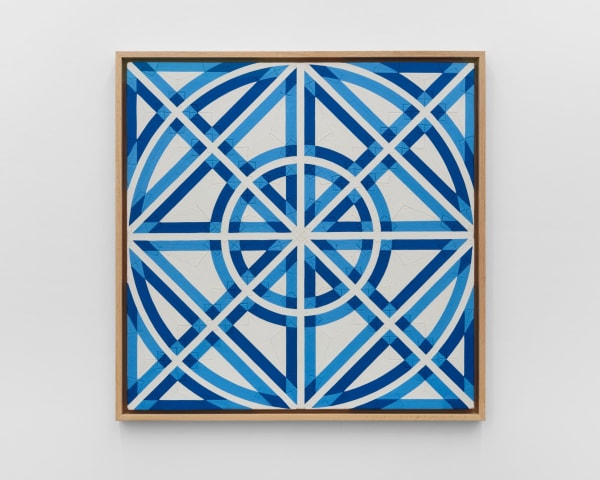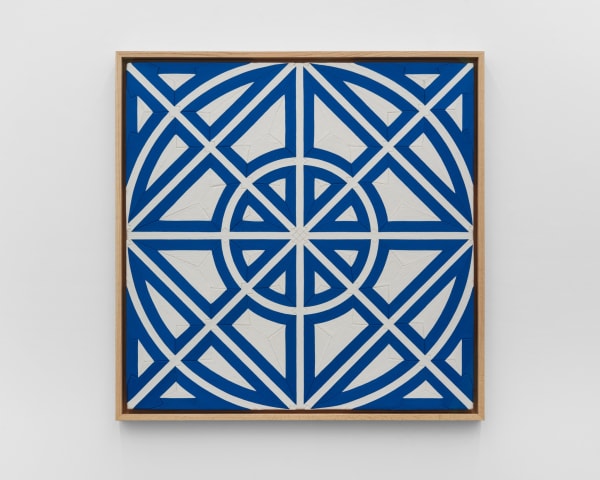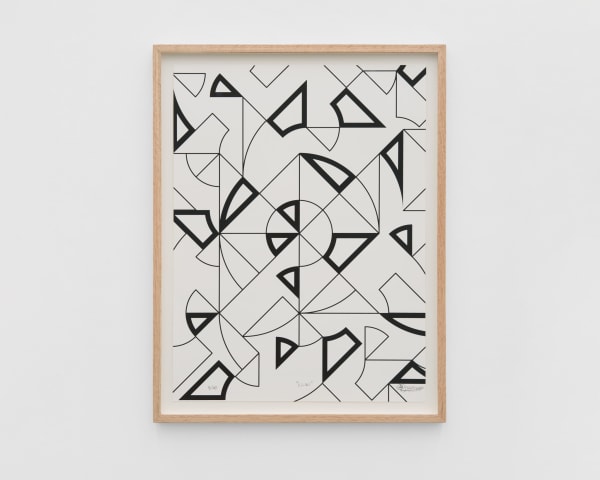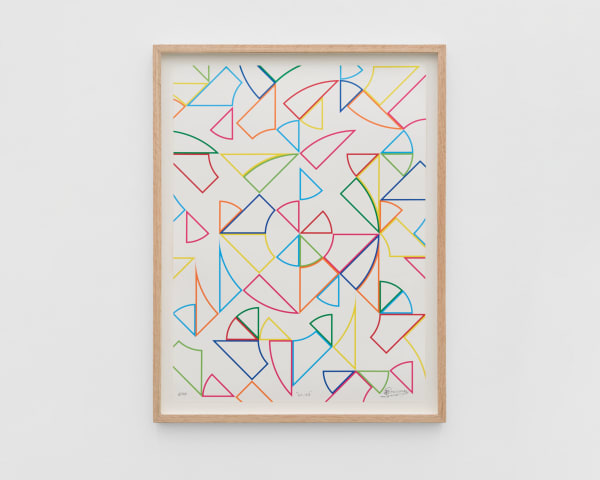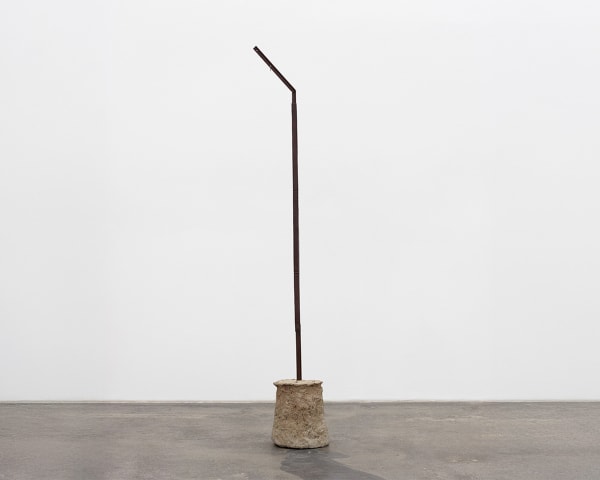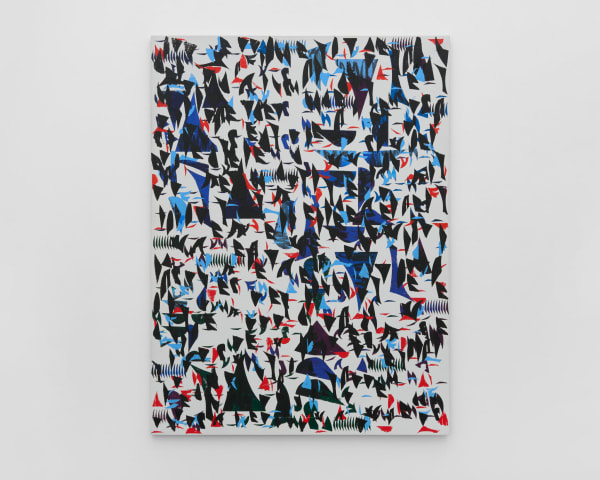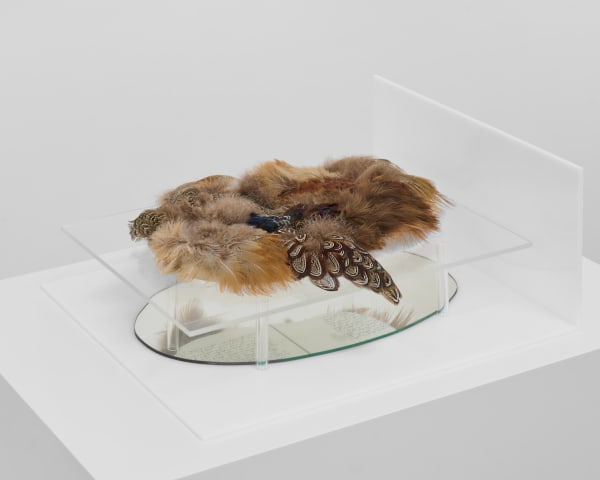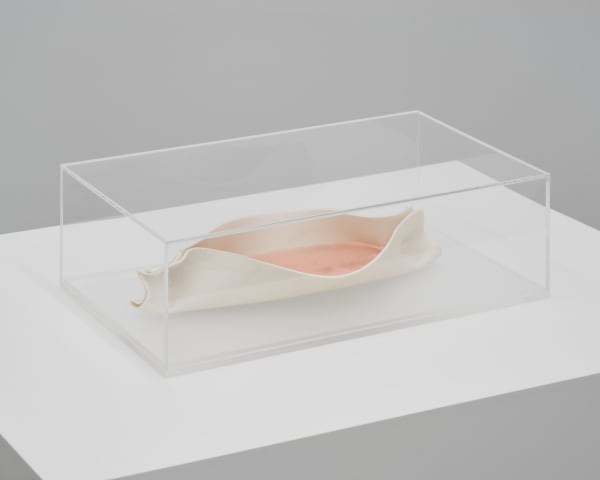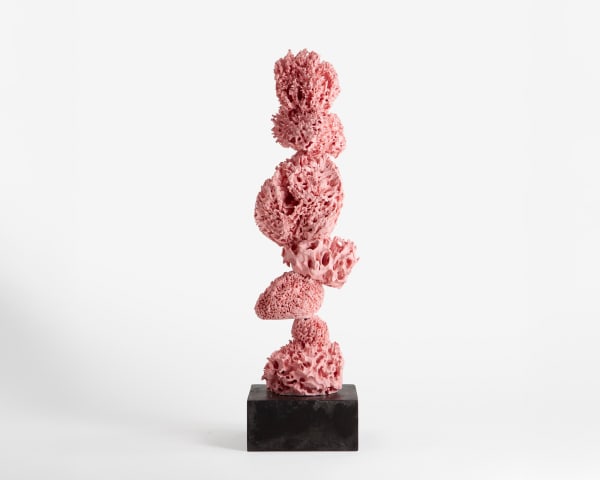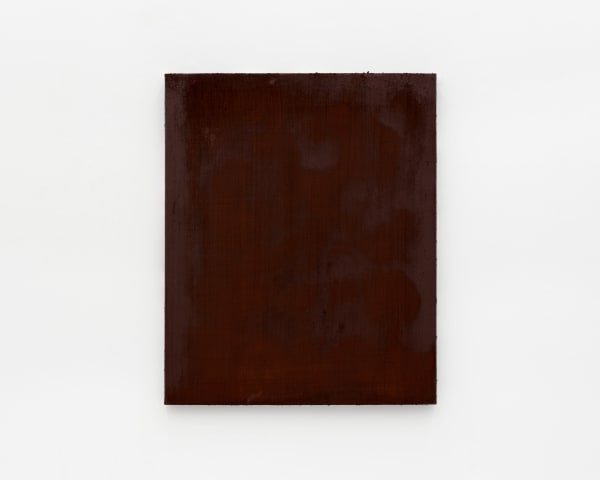-
Booth 33
August 28 - 31, 2025
-
-
Eduardo Terrazas
Eduardo Terrazas (b. 1936, Mexico) draws from a geometric language and a method inspired by the tablas of the Huichol, an Indigenous Mexican tribe. Using symmetrical structures as matrices for countless variations, Terrazas explores cosmic concepts, placing the earth at the center and the celestial dome at the periphery, while essential forces – gravitational, electromagnetic, and nuclear – compete for the space in between.The technique involves affixing colored wool onto wooden panels coated with Melipona bee wax, acting as an adhesive. The thread moves along, reproducing the lines, curves, meanders, and changes of direction required by the motif. This process entails tirelessly repeating back and forth movement, during which each strand is tightly glued along the previous one, leaving no gaps or openings between them. -
-
Jone Kvie
Here, Here is a series of sculptures based on photographs of found objects that Jone Kvie (b. 1971, Norway) has collected, documenting markings in urban spaces. Wiry metal rods extend from blocks of concrete or marble, as if unearthed from the streets. These are the kinds of man-made objects not designed to draw attention, but rather to serve as temporary solutions to a problem or a need. By translating the original elements into new materials through sculpting and casting, Kvie creates works that bear witness to a different origin. He lifts the objects from their temporary function into another temporality and visibility.Time is a fundamental consideration in Kvie’s sculptures: the choice of materials and the specific way he treats them shape how we perceive the work. With our limited experience of time, Kvie engages with its vastness – both in a geological and cosmic sense. What is often too immense to grasp as a human, we are invited to encounter, or at least glimpse, in his work, as time in its various forms is embedded within the sculptures. -
-
Carlos Amorales
Carlos Amorales (b. 1970, Mexico) is a multidisciplinary artist who explores the limits of language and translation systems to venture into the field of cultural experimentation. He uses graphic production as a tool to develop linguistic structures and alternative working models that allow new forms of interpretation and foster collectivity.
Fragmented Typefaces 1-12 is a series of paintings produced by applying several layers of oilstick on the stenciled canvas. The graphic yet pictorial quality of the works is due to fact that the artist decided to experiment with the crossover between typographical text with painting technique. The works present irregular patterns of abstract shapes that are taken from one of Amorales’ encrypted typographic alphabets that has been used on previous projects. The works that include “readable” text, are cancelled by superimposing the abstract shapes. These texts are prose poems written by the artists, which describe autobiographical events that are then partially hidden. The abstract works of chaotic pattern resemble pictographic writing.
These paintings evoke a fragmented sense of meaning that dwells between legibility and illegibility.
-
-
Gardar Eide Einarsson
Gardar Eide Einarsson’s (b. 1976, Norway) recent gouaches on paper transform fragments of closed-captioning text from film and television into stark, text-based compositions. Disembodied phrases – once cues for sound, gesture, or music – are set against saturated monochrome backgrounds, becoming carriers of mood and psychological tension. Stripped of their original context, they hover between the poetic and the foreboding, inviting the viewer to confront the tension between visibility and absence, narrative and silence.At the centre of Einarsson’s practice is a critical inquiry into systems of control, identity, and perception. By using closed-captioning, designed to translate sound into visual information, he prompts reflection on how meaning is constructed in the ab- sence of clarity. This results in a charged stillness that challenges our reliance on mediated narratives to understand the world. -
-
Rebecca Lindsmyr
In we’ll analyze at breakfast, Rebecca Lindsmyr continues her exploration of painting as a psychological and linguistic field, a space where meaning is layered, deferred, and continuously renegotiated.
The work unfolds through acts of overwriting and glazing, resulting in a densely built surface that resists fixed readings. Rather than building toward an image, the painting evolves through a process of accumulation and erasure, echoing the fragmented logic of memory and thought.
In an effort to emphasize the intertextuality of gesture and language, this work marks a shift in Lindsmyr’s approach to titles, where a series of tentative expressions builds up and leaks into the process of naming. Rather than acting as a direct caption, the title lingers as a conceptual echo, hinting at a reflective aftermath; a line drawn from a tangled web.
With this work, Lindsmyr’s temporal and psychological approach to painting becomes evident. While suggested as a surface, the work points to a depth of strata, simultaneously contained and concealed, through which perception continues to unfold.
-
-
Charlotte Brüel
In Charlotte Brüel’s (b. 1945, Denmark) Vertical Views series, the common denominator is the use of opal glass and mirror. The round surface of the mirror reflects various fragments of the artist’s work journal, parts of a photocopy of a painting, and a collection of pheasant feathers. Despite its rather straightforward appearance, the materials create a mirror-effect which has a determining influence on how the work is being perceived.
The combination of materials establishes a transverse gaze that moves from the top and down through the center axis of the sculpture. However, the sculpture is composed in a way so that the content is only partly visible from the otherwise open and relatively transparent form. The text that appears from the inside of the sculpture can only be accessed in fragments which will only appear when moving around it. The sculpture gives you the feeling that there is more to learn besides the visible. In this way, the works offer a strong narrative reminding us that knowledge is essential to ensure that the human worldview does not stagnate by the surface.
-
-
Tove Storch
In this series by Tove Storch (b. 1981, Denmark), thin porcelain bowls cradle bars of soap cast directly into their fragile interiors, all enclosed within the transparent boundaries of a plexiglass case. The porcelain functions as a rigid shell, shaping and containing the soft, malleable soap, which slowly yields to time, evaporation, and touch. This interplay between the hard and the yielding becomes a quiet meditation on containment and transformation, on the structures that hold and the matter that adapts within them.
As with much of Storch’s practice, the work balances precise formal clarity with an underlying bodily resonance. The materials, seemingly at odds, generate a subtle tension between fragility and resilience, intimacy and distance. Encased in its clear shell, the piece invites close viewing yet remains untouchable, height- ening awareness of both presence and separation.
-
-
Michael Kvium
In Michael Kvium’s (b. 1955, Denmark) Silent Scene (2025), the composition unfolds across three panels, each carrying its own atmospheric weight yet forming a unified psychological landscape. A vast, unsettled sky stretches across the first, its layered tones suspended between calm and foreboding, holding the viewer in a quiet tension. At the centre, one of Kvium’s unmistakable figures emerges – at once confrontational and exposed, a presence that feels both deeply human and curiously detached. The figure becomes a reminder of our own vulnerabilities, suspended in the fragile space between recognition and estrangement.From the edge of the frame, the thorned silhouette of a cactus pushes inward, interrupting the stillness with a slow, deliberate intrusion. It carries with it the weight of survival, resilience, and the quiet defences life constructs in order to endure. While less overtly theatrical than much of Kvium’s earlier work, the triptych sustains his enduring engagement with mortality, endurance and the shifting states of human existence. The images hover between beauty and unease, inviting contemplation of the forces, both internal and external, that shape the arc of life.
-
-
SUPERFLEX
Proposal for the World’s Second-Tallest Building consists of ceramic replicas of sponges, stacked vertically. Based on SUPERFLEX’s yearslong research into constructing human infrastructure that also accommodates other species, the work proposes a new skyscraper—the second-tallest in the world—designed to resemble sponges, an ancient type of marine organism vital to ocean ecosystems.To make the work, the sponges have been painstakingly replicated; even the tiniest, most delicate details have been copied. Assembled into a tower, they suggest a new urban landscape built on the principles of organic life. Skyscrapers are designed to keep the elements out, but with this proposal, the porosity of the sponges would allow air and water to circulate through the building, creating an unpredictable flow of matter and life. Because all spaces in a sponge are connected, visitors can move from room to room vertically, horizontally, diagonally, or in any direction—the world’s second-tallest building will be infinitely traversable. -
-
Tom Sandberg
Central to Tom Sandberg’s (1953 – 2014, Norway) practice is his subtle darkroom work. His modulated greyscales – deep blacks like volcanic glass, soft whites like frosted crystal – give the images a tactile presence that almost exceeds photography itself. This precise calibration of light and tone shapes the atmosphere of stillness and unease that defines much of his work.Encountering Sandberg’s photographs means sensing not only what they show, but how they refract perception. Like quiet mirrors, they capture the fleeting threshold between clarity and dissolution. Looking becomes both recognition and estrangement – as if the familiar world were momentarily made strange. This perceptual tension heightens awareness, as shadows and surfaces gain a delicate intensity, leaving the viewer on the verge of grasping something just out of reach. -
-
FOS
In this work, FOS uses Jesmonite to create a fractured relief whose textured, blackened surface is cut through by vivid seams of blue. The broken segments hover slightly apart, allowing light to enter and animate the voids between them. The composition feels at once ancient and contemporary, as if excavated from an imagined archaeology, and operates less as a fixed image than as a fragmentary language – a constellation of forms that invite the viewer to piece together meaning.Working across sculpture, installation, music, architecture, and design, FOS explores how objects and spaces shape us as social beings, often creating environments for interaction and exchange. His practice examines how art can function as an alternative to the systems that regulate behaviour in civil society, here using the material and spatial qualities of sculpture to meditate on rupture and connection, solidity and the spaces that divide it. -
-
Runo Lagomarsino
In this series of works, Runo Lagomarsino (b. 1977, Sweden) presents a ghostly map of South America, created using the lumen print process. On light-sensitive photographic paper, the continent emerges as a faint, ephemeral image - its borders blurred and gradually fading over time. The delicate surface bears visible tape marks, suggesting an act of repair or reconstruction, as if attempting to hold together something fragile and fragmented.
These gestures evoke histories that are often overlooked or fractured, challenging the authority of traditional cartography and colonial narratives. Ghostmaps reflects on identity, displacement, and the lingering traces of colonialism, offering a map that resists certainty and instead embraces impermanence and ambiguity. As its title suggests, “I Am Not Who They Think I Am”, the work questions fixed perceptions of both place and self.
-
-
Nils Erik Gjerdevik
The artistic practice of Danish-Norwegian artist Nils Erik Gjerdevik (1962 - 2016) encompassed painting, ceramic sculpture, and works on paper. He is known for his non-figurative paintings that challenge conventional rules and expectations of the medium. Through unusual formats, alternative color palettes, and compositions rarely guided by classical notions of harmony, Gjerdevik constantly questioned how a painting should be seen and experienced.
His works often unite seemingly opposing ideas and move- ments into a single, cohesive image, creating a tension between divergence and unity. This approach extends across his drawings and ceramic pieces, where distinctions between foreground and background blur and traditional perspectives are subtly subverted.
-
-
Mads Gamdrup
Mads Gamdrup's (b. 1967, Denmark) monochrome oil paintings explore the materiality of color through layered, hand-ground pigments. Balancing transparency and density, the surfaces reveal subtle shifts in tone and light. While seemingly minimal, each work contains traces of movement – gestural brushstrokes and the imprint of the hand – inviting slow, attentive looking.
Rooted in a decades-long engagement with photography, these paintings continue Gamdrup’s investigation into light, color, and perception. By reducing the image to a single color, he creates space for reflection and sensory experience, where meaning emerges not from depiction but from the act of seeing.
-
-
For general inquiries, please contact: inquiry@nilsstaerk.dk
